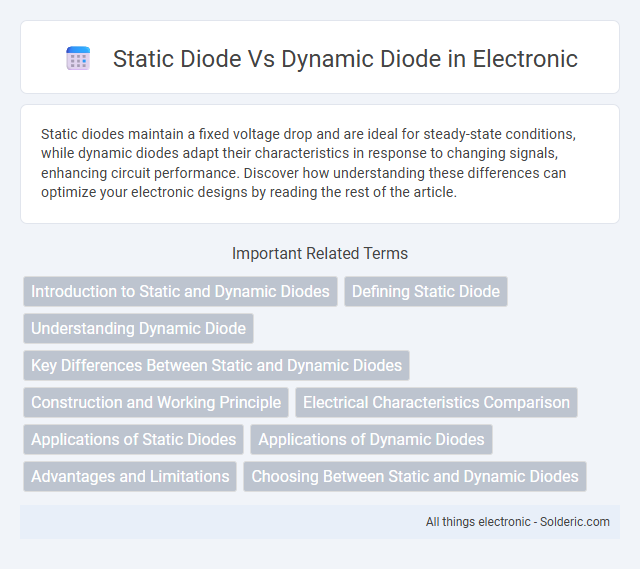Static diodes maintain a fixed voltage drop and are ideal for steady-state conditions, while dynamic diodes adapt their characteristics in response to changing signals, enhancing circuit performance. Discover how understanding these differences can optimize your electronic designs by reading the rest of the article.
Comparison Table
| Feature | Static Diode | Dynamic Diode |
|---|---|---|
| Function | Allows current flow in one direction under steady conditions | Facilitates current flow during varying or transient circuit conditions |
| Application | Rectification, voltage clamping in DC circuits | Switching circuits, protection during rapid state changes |
| Response Time | Relatively slower, steady-state operation | Fast response to transient signals |
| Behavior | Constant forward conduction with fixed threshold | Variable conduction based on circuit dynamics |
| Examples | Standard silicon diode, Zener diode | Schottky diode, Fast recovery diode |
Introduction to Static and Dynamic Diodes
Static diodes are semiconductor devices designed to allow current flow in one direction under steady-state conditions, commonly used in rectification and voltage clamping applications. Dynamic diodes, in contrast, operate under varying voltage and current conditions, often employed in switching and high-frequency circuits where rapid response to signal changes is critical. Understanding the fundamental differences between static and dynamic diodes is essential for optimizing performance in power electronics and signal processing systems.
Defining Static Diode
A static diode is a semiconductor device that allows current flow primarily in one direction under steady-state conditions, maintaining consistent electrical characteristics without significant variation over time. Unlike dynamic diodes, which adapt their behavior based on changing signals or environments, static diodes are designed for fixed, unchanging operational roles in circuits. Your choice between static and dynamic diodes depends on the specific electrical requirements and the need for stability versus flexibility in current conduction.
Understanding Dynamic Diode
Dynamic diode refers to a diode operating under varying voltage and current conditions, adapting to changes in real-time circuits, unlike static diodes which function under fixed voltage levels. Understanding dynamic diode behavior is crucial for designing circuits with fluctuating signals, as it affects switching speed, signal integrity, and power efficiency. Your knowledge of dynamic diode characteristics improves the performance of systems requiring rapid response to changing electrical environments.
Key Differences Between Static and Dynamic Diodes
Static diodes maintain a fixed electric charge and voltage drop under steady-state conditions, ensuring consistent rectification and minimal power loss in circuits. Dynamic diodes, on the other hand, adapt their behavior in response to changing electrical signals, providing improved switching speeds and efficiency in high-frequency applications. Understanding these key differences helps optimize your circuit design for stability or responsiveness depending on your specific electronic requirements.
Construction and Working Principle
Static diodes consist of a simple p-n junction designed to allow current flow in one direction under steady-state conditions, with minimal response to rapid voltage changes. Dynamic diodes incorporate additional semiconductor layers or circuits to handle varying voltage and current during transient events, enabling faster switching and enhanced protection in dynamic environments. The working principle of static diodes relies on the inherent property of unilateral conduction, while dynamic diodes adaptively regulate current flow to mitigate voltage spikes and surges.
Electrical Characteristics Comparison
Static diodes exhibit a fixed forward voltage drop typically around 0.7V for silicon types, maintaining consistent electrical behavior under steady-state conditions, while dynamic diodes demonstrate variable forward voltage that adjusts rapidly in response to transient electrical signals. Static diodes have slower response times and higher junction capacitance compared to dynamic diodes, which possess low junction capacitance and fast switching speeds, making them ideal for high-frequency applications. The leakage current in static diodes tends to be higher due to thermal equilibrium, whereas dynamic diodes minimize leakage current through rapid adaptation to changing electric fields.
Applications of Static Diodes
Static diodes are primarily used in applications requiring steady-state rectification such as power supplies, voltage multipliers, and signal demodulation circuits. Their ability to handle constant current makes them ideal for protecting circuits against voltage spikes and ensuring reliable performance in DC power systems. Your designs benefit from static diodes' robustness in environments where consistent directional current flow is essential.
Applications of Dynamic Diodes
Dynamic diodes are primarily used in high-frequency switching circuits and signal modulation applications where rapid response and low capacitance are critical. They play a crucial role in RF mixers, oscillators, and fast-switching rectifiers due to their ability to handle transient signals efficiently without significant distortion. These characteristics make dynamic diodes ideal for communication systems, radar technology, and advanced signal processing devices.
Advantages and Limitations
Static diodes offer simplicity and reliability with lower power consumption, making them suitable for fixed bias and low-frequency applications, but they lack adaptability in varying signal conditions. Dynamic diodes provide improved efficiency and responsiveness under fluctuating signals and high-frequency operations, yet they involve increased complexity and higher power requirements. Choosing between static and dynamic diodes depends on the specific application's need for stability versus performance adaptability.
Choosing Between Static and Dynamic Diodes
Choosing between static and dynamic diodes depends on the specific application requirements, such as response time and switching speed. Static diodes are ideal for steady-state or DC conditions due to their fixed conduction properties, while dynamic diodes excel in AC or rapidly changing environments by adapting their behavior during operation. Understanding the electrical load characteristics and signal frequency is essential for optimizing performance and ensuring reliability in electronic circuits.
Static diode vs Dynamic diode Infographic

 solderic.com
solderic.com